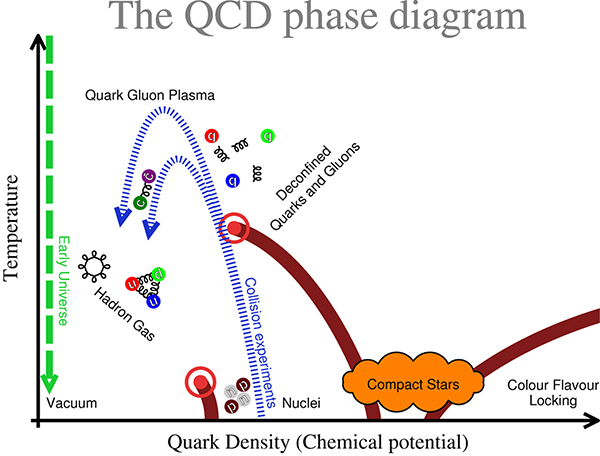ELEMENTARY PARTICLE PHYSICS
Heavy Ion Phenomenology Form Lattice Simulations
Principal Investigator:
Szabolcs Borsányi
Affiliation:
Institut für Theoretische Physik, FB-C, Universität Münster (Germany)
Local Project ID:
PRA070
HPC Platform used:
JUQUEEN of JSC
Date published:
Ordinary matter, such as lead or gold, may feature very peculiar behaviour under extreme conditions. The heated metal melts then evaporates. At even higher temperature the atoms disintegrate, shedding off electrons and become ions. After more heating these ions fall into pieces: protons and neutrons.
But even higher temperatures are achieved in heavy ion collision experiments, e.g. the Large Hadron Collider (Geneva, Switzerland) or the Relativistic Heavy Ion Collider(Brookhaven, US). Gold and lead ions are smashed together at close to light velocity. The heat of the collision is sufficient to melt protons and neutrons (T=1.74 x 109 K) and a hot plasma is left behind. Scientists do have a theoretical picture what this plasma is composed of: quarks and gluons, which are the very ingredients of protons and neutrons, according to theory. Thus this new form of matter is simply called quark gluon plasma.
This short lived plasma has some remarkable features. It has virtually no internal friction, like a superfluid soup and only few particles are able to fly through. In this project, a team of scientists studied the energy density, entropy, specific heat and pressure of this plasma starting from a high temperature at its creation to a low temperature where the plasma actually freezes. This temperature drop takes just 10-23 seconds.
When the plasma freezes its matter is transformed into a large number of subatomic particles. One observes several different type of particles not only protons and neutrons that were used to create them. And yet more types of particles emerge that either bypass the detectors or decay into simpler ones on the way towards detection.
So, at what point does the plasma break up? Down to which temperature does this new form of matter, the quark gluon plasma, survive? There is no thermometer device that you could simply slip into the plasma.
To identify this breakup point, the research team pursued two approaches:
1) One can rely on theory and study the equations of quarks and gluons, the so called Quantum Chromodynamics (QCD) on a space-time lattice. This requires large-scale simulations sampling the several likely possibilities for the strength and orientation of the gluon and quark fields. Averaging thermo-dynamical observables over thousands of such configurations will give the theoretical description. A temperature scan will reveal a pattern of a smooth transition between the particle phase and the plasma. Using ever finer lattices, a characteristic temperature emerges that is independent on the details of the calculation.
2) From the experimental side the characteristic temperature of this smooth transition is associated with the point where the plasma cools down and falls apart into particles. This moment, the freeze-out, leaves traces in the particle distribution, which is reconstructed from the detected signals.
Then again, the scientists use lattice calculations to find out at which temperature the plasma must disintegrate to match the theoretical distribution to the experimental result. The computer resources allocated through PRACE enabled the team to carry out lattice calculations with a high spatial resolution (approx. 10-16 m). In this project, a temperature scan was required as well as a continuum extrapolation in which the same parameters were calculated on coarser and finer lattices. The BLUE Gene Q system of JSC Jülich was the ideal supercomputer for the job, as because of its extreme scalability small as well as large lattices could be calculated on the same system. (Note: The calculation for only one single temperature and lattice spacing could take years on a desktop computer.)
While this simulation project was carried out, the STAR experiment at LHC published observed particle distributions for various beam energies. It was highly interesting for the simulation project team to find out which lattice simulation agrees with the experimental data. It was found that the matching simulation had the temperature around or just below the transition temperature that was predicted by the so called QCD (method number 1), ~1.7 x 109 K.
A total of more than 90 million core hours of computing time on JSC supercomputer JUQUEEN was granted for this project which was made possible through the Partnership for Advanced Computing in Europe (PRACE). The joint research team consisted of physicists of the Bergische Universität Wuppertal (Germany) and the Eotvos University (Hungary).

© Bergische Universität Wuppertal, Theoretische Physik, Fachbereich C
Szabolcs Borsányi
Theoretische Physik, Fachbereich C - Bergische Universität Wuppertal
D-42097 Wuppertal/Germany
e-mail: borsanyi@uni-wuppertal.de